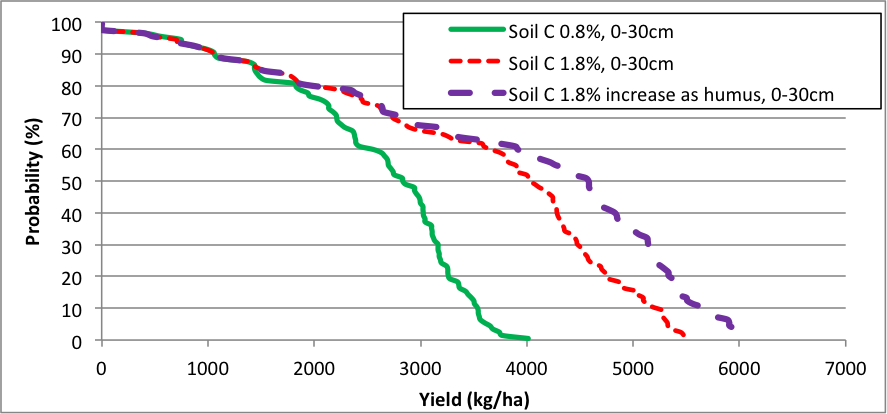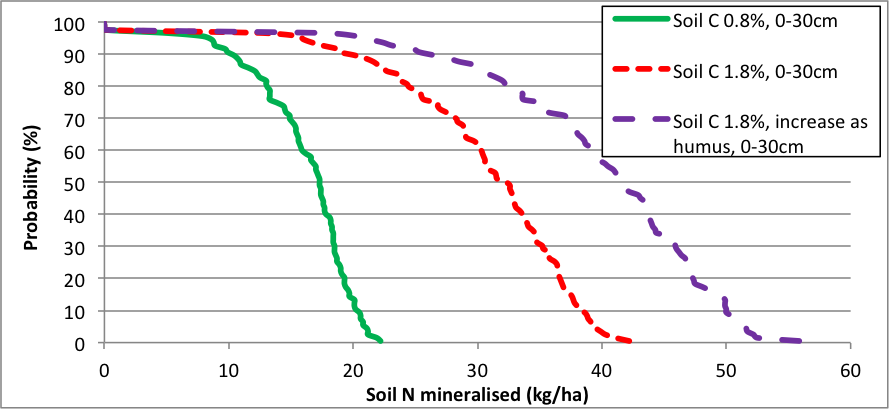Soil organic matter - what does it mean for you?
Author: Harm van Rees, Brian Murphy, Enli Wang, Jeff Baldock, Frances Hoyle, David Lawrence, Bhupinder Pal Singh and Peter Thorburn, | Date: 27 Aug 2014
Authors
Harm van Rees (Cropfacts P/L), Brian Murphy, Enli Wang (CSIRO), Jeff Baldock (CSIRO), Frances Hoyle (DAFWA), David Lawrence (QDAFF), Bhupinder Pal Singh (NSW DPI), Peter Thorburn (CSIRO).
Take home messages
- Soil organic matter plays a critical role in maintaining the productive capacity of soils.
- The particulate, humus and resistant organic carbon fractions contribute to different functions in the soil.
- Increasing the soil organic matter content of soils takes time and requires higher levels of carbon inputs and reduced levels of carbon outputs.
- Soil organic matter plateaus at an equilibrium level for a given management system (decreases or increases are not continuous).
Aims:
- To discuss the benefits of soil organic matter on the productive capacity of the soil; and
- To identify the importance of different fractions.
What is soil organic matter?
Soil organic matter (SOM) is derived from decaying plant and animal matter and according to fractionation methodology, consists of three carbon fractions:
- Particulate Organic Carbon (POC) – decomposing plant and animal material (size: 0.05 to 2mm).
- Humus Organic Carbon (HOC) – decomposed material found as large organic molecules attached to soil particles (size: <0.05mm).
- Resistant Organic Carbon (ROC) – inert material, mostly charcoal.
The stability of each of these fractions is very different. Particulate Organic Carbon (POC) is the least stable fraction. It lasts only months or at the most one or two years before the carbon is either lost to the atmosphere as carbon dioxide (CO2), or is decomposed further into humus. Humus Organic Carbon (HOC) is a relatively stable fraction and can last in the soil for decades. Resistant Organic Carbon (ROC) is mostly charcoal and is very stable and may last 100s of years.
Soil type and vegetation management will affect POC and HOC levels, but ROC levels are historical and change very little.
Functions of soil organic matter
Soil organic matter (SOM) plays an essential role in maintaining the productive capacity of agricultural soils and higher levels of SOM can improve the physical, chemical and biological functionality of the soil.
- Physical: SOM improves aeration and soil structure, increases plant available water (PAW), lowers bulk density, and protects the soil against wind and water erosion by binding soil particles.
- Chemical: SOM contributes to the cation exchange capacity of the soil, acts as a buffer against acidification and maintains the availability of phosphorus (P); by binding to iron (Fe) and aluminium (Al).
- Biological: SOM provides energy for micro-organisms and releases plant available nitrogen in the form of nitrate and ammonium during its decomposition.
The importance of soil organic matter fractions
The three fractions of SOM have distinctly different functions in the soil. Understanding each of their functions will help to manage and possibly increase the POC and HOC fractions.
|
Soil Function |
Particulate Organic Carbon (POC) |
Humus Organic Carbon (HOC) |
Resistant Organic Carbon (ROC) |
|---|---|---|---|
|
Physical properties |
|||
|
Increased infiltration (better soil structure) |
√√√ for sands and loams √ for clays |
√ for all soil types |
√ |
|
Tilth (improved structure, friability) |
√√√ for sands and loams X for clays |
√√ for sands and loams √ for clays |
√ |
|
Lowering bulk density |
√√ for sands and loams √ for clays |
√ for all soil types |
√ |
|
Increasing Plant Available Water |
X |
√ for all soil types |
√ |
|
Chemical properties |
|||
|
Improved Cation Exchange Capacity |
X |
√√√ for sands and loams X for clays |
√ for sands and loams |
|
Buffer against acidification (binds to Fe and Al) |
X |
√√√ for sands and loams X for clays |
√ |
|
Biological properties |
|||
|
Food source for micro-organisms |
√√√ for all soil types |
√√√ for all soil types |
√ for all soil types |
|
Release of nitrate and ammonium |
√ for all soil types |
√√√ for all soil types |
√ for all soil types |
How can SOM be increased? – With particular reference to the different fractions
Particulate Organic Carbon (POC): Stubble retention and reduced tillage results in an increase in this fraction within the total SOM pool. This fraction is unstable and during drought years with low crop or pasture production this fraction can decrease markedly.
Humus Organic Carbon (HOC): Current research indicates that the humus organic carbon content can be increased if sufficient nutrients are added to stubble for the soil microbial population to break-down the stubble into humus. The research undertaken by Clive Kirkby (CSIRO) and farmer demonstration projects are investigating management practices which can result in an increase in the humus fraction of the total SOM pool.
Quantifying functions of SOM
The quantification of the functions of soil organic matter forms the basis of a research program funded by GRDC (‘Improved Management of Soil Organic Matter for Profitable and Sustainable Cropping’), which is also supported by DA (Federal Department of Agriculture). On the completion of the project it is envisaged that the functions of SOM and its component fractions will have been identified and quantified in relation to their importance to improve soil quality and crop production.
What is currently known of the benefits of increasing soil carbon content?
By using the simulation model APSIM, the impact of increasing SOM levels can be investigated.
Impact of SOM on yield
Increasing Soil Carbon from 0.8% to 1.8% (0-30cm soil layer) has a marked positive outcome on yield (APSIM simulation on a Temora Brown Chromosol soil (APSoil no. 179) – also known as a brown duplex soil; using 100 years of BoM Temora weather data) (Figure 1). Note: in the APSIM set up, 50kg of N was applied at seeding.
Figure 1. APSIM simulation of grain yield demonstrating the impact of increasing soil C, by increasing total soil carbon and by increasing the humus fraction only, on a Temora Brown Chromosol.

Figure 1 text description: The yield (kg/ha) increased as the probability (%) decreased. Soil with Carbon increase as humus of 1.8% had the greatest yield for lowest probability at approximately 6000kg/ha. Soil with Carbon increase of 1.8% had a yield of approximately 5500kg/ha for lowest probability. Soil with Carbon increase of 0.8% had the lowest increase for lowest probability at approximately 4000kg/ha.
Impact of increased PAW on yield
Increasing soil carbon from 0.8% to 1.8% (0-30cm soil layer) resulted in a small increase in PAW, which in turn resulted in a very small potential increase in yield (Figure 2).
Figure 2. APSIM simulation of grain yield demonstrating the impact of increasing soil C resulting in a higher Plant Available Water (PAW) on a Temora Brown Chromosol (APSoil no. 179).

Figure 2 text description: The yield (kg/ha) increased as the probability (%) decreased. There was not a significant difference found in the yields between Plant Available Water in soil with Carbon increase 0.8% compared to soil with Carbon increase of 1.8%. Both showed a yield around the 7000kg/ha at the lowest probability.
Impact of SOM on mineralisation of N
During the cropping season, SOM is mineralised to available N (nitrate and ammonium). The extent of N mineralisation was modelled, using APSIM, for baseline SOM (SOC 0.8%); increased SOC at 1.8%, and increased SOC at 1.8% but with the increased carbon attributed only to the Humus fraction (Figure 3). Increasing SOC by 1% resulted in an increase of 15 kg/ha of available N (at 50% probability) but if the increase in SOC was all attributed to the humus fraction then mineralisation was increased to 25 kg/ha of available N (Figure 3).
Figure 3. APSIM simulation of N mineralisation from a baseline SOC content (0.8% SOC), an increase of 1% in SOC, and an increase of 1.0% in the humus fraction only.

Figure 3 text description: The soil Nitrogen mineralised (kg/ha) increased as the probability (%) decreased in all three varying soil Carbon levels. Soil with 1.8% Carbon, increase as humus showed the highest Soil N mineralised for lowest probability at approximately 55 kg/ha. Soil with 1.8% Carbon but with no increase in the humus reached Soil N mineralisation of approximately 42kg/ha for lowest probability. The baseline Soil with 0.8% Carbon had the lowest Soil N mineralised for lowest probability at approximately 22kg/ha.
Summary
- Soil Organic Matter (SOM) can be separated into three distinct fractions (POC - Particulate Organic Carbon; HOC – Humus Organic Carbon; and ROC – Resistant Organic Carbon).
- Each of the fractions of SOM has different beneficial attributes, and these attributes are dependent on soil type.
- Increasing SOM results in a small increase in PAW. Correspondingly, the small increase in PAW results in a very small increase in yield (simulated using APSIM).
- The greatest benefit of increasing SOM to crop yield comes from increased N mineralisation and subsequent release of plant-available N. Most of the benefits from increased N mineralisation of SOM can be attributed to the Humus fraction.
- Research, funded by GRDC and the Federal Dept. of Agriculture, into the beneficial aspects of soil organic matter is ongoing.
Further reading
Hoyle (2013). ‘Managing Soil Organic Matter – a practical guide’ published by the GRDC.
Contact details
Harm van Rees
0419 325252
Was this page helpful?
YOUR FEEDBACK
